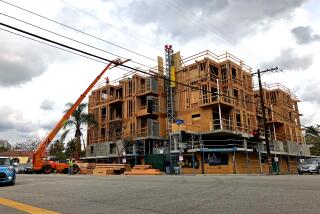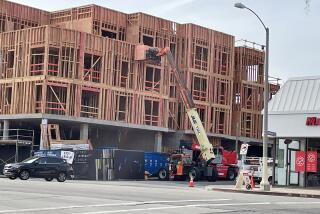Lower Buildings : Council OKs Density Lids in La Jolla
- Share via
Hoping to ease the impact of runaway residential and commercial growth in La Jolla, the San Diego City Council agreed Tuesday to slash the permissible size of future office buildings and reduce density in the downtown core of the tony seaside community.
The council voted 7 to 2, with Councilmen Bruce Henderson and Bob Filner dissenting, to approve a series of alterations to the key planning blueprint governing land use in La Jolla.
Under the new regulations, the maximum size of office buildings will be cut in half, with space limited to 5,000 square feet on a single lot, regardless of the size of the parcel. Residential densities in several sections of the community were reduced from 43 units an acre to 29 units under the updated land-use provisions.
2-Story Limit
The existing 30-foot height restriction for office buildings will remain unaltered, but office structures built along several major downtown thoroughfares, among them Girard Avenue and Pearl Street, will be limited to two stories instead of three.
Also, the council endorsed several street improvements that were spotlighted in a 1985 study of La Jolla’s traffic-clogged streets. Among the recommendations under consideration are realignment of the gridlocked intersection of La Jolla Shores Drive and Ardath and Torrey Pines roads.
Underlying each of the changes enacted by the council was an important theme--to draw a line on development and its impact in La Jolla. For decades a quiet village nestled between steep coastal hills and the Pacific, the community has grown increasingly congested. Office and commercial construction has boomed and traffic volume along major roads has grown apace.
“Certainly we all agree that La Jolla doesn’t look like a sleepy village anymore,” noted Councilwoman Abbe Wolfsheimer, whose district includes the community. “But there’s plenty to preserve, and this is a chance to do it.”
Mayor Maureen O’Connor agreed, saying the changes “may not be perfect,” but should help point toward the goal of retaining “the essence of the La Jolla we all loved.”
Henderson, however, suggested that the 5,000-square-foot limit on office buildings represented too severe a restriction on owners of large lots, which could accommodate larger structures. “We may be poking a few people in the eye with a stick” with the limit, he said.
Filner Questions Changes
Filner, meanwhile, questioned whether the changes in La Jolla’s key planning constitution might be better enacted after a more extensive review. Just such a process is scheduled to take place next year.
“Sometimes we have the responsibility to say, hey, maybe we ought to take a more planned, thoughtful look,” Filner said.
But Councilman Ron Roberts argued that more wide-ranging study might simply be a waste of time.
“I think we’re taking a step to help,” Roberts said. “Let’s stop hiding behind the paralysis of analysis. . . . We can always spend more money on planning, or we can get on with it.”
Too Much Office Space
Leaders of the La Jolla Planning Assn. and the La Jolla Town Council, which supported most of the moves made by the council Tuesday, said the community now has a vast oversupply of office space, with more than 1-million square feet. About one-fifth of that remains unoccupied.
The herd of attorneys, accountants and other office workers who come and go from those complexes each day only aggravates the traffic during peak hours, members of the two groups contend.
They suggested that the new land-use regulations should prevent matters from worsening. Mark Steele, Town Council vice president, said the council action “represents a clear compromise that will stick in the community. There’s a lot of intelligence in the proposal, a lot of hard work.”
But members of La Jollans for Responsible Planning, a citizens group that banded together earlier this year to oppose changes in the community’s land-use document, said the council’s action Tuesday would do little good.
The changes “may have severe impacts on property owners and the community,” but will not ease congestion on the roads, said Dan Irwin, a leader of the group.
He suggested that the solution to the community’s traffic woes lies in highway improvements. “La Jolla has already been downzoned, now it’s time to improve the infrastructure,” Irwin said.
But members of the Town Council and La Jolla planning group have balked at most proposed street projects, saying they would split neighborhoods and further erode the character of the community, with speeding cars endangering pedestrians and bicyclists.
The council first ordered changes in the community’s land-use document, called the La Jolla Planned District Ordinance, during a marathon meeting in March that drew about 500 residents. Although the council gave its staff 60 days to return with recommendations from the planning commission, the issue was caught in a bureaucratic logjam with the recent efforts to draft a citywide slow-growth ordinance for the November ballot.
More to Read
Sign up for Essential California
The most important California stories and recommendations in your inbox every morning.
You may occasionally receive promotional content from the Los Angeles Times.










